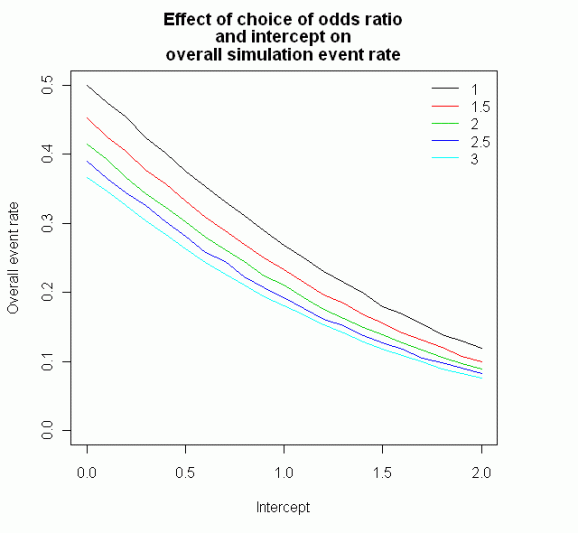Logistic regression – simulation for a power calculation…
Want to share your content on R-bloggers? click here if you have a blog, or here if you don't.
Please note – I’ve spotted a problem with the approach taken in this post – it seems to underestimate power in certain circumstances. I’ll post again with a correction or a more full explanation when I’ve sorted it.
So, I posted an answer on cross validation regarding logistic regression. I thought I’d post it in a little more depth here, with a few illustrative figures. It’s based on the approach which Stephen Kolassa described.
Power calculations for logistic regression are discussed in some detail in Hosmer and Lemeshow (Ch 8.5). One approach with R is to simulate a dataset a few thousand times, and see how often your dataset gets the p value right. If it does 95% of the time, then you have 95% power.
In this code we use the approach which Kleinman and Horton use to simulate data for a logistic regression. We then initially calculate the overall proportion of events. To change the number of events adjust odds.ratio. The independent variable is assumed to be normally distributed with mean 0 and variance 1.
nn <- 950
runs <- 10000
intercept <- log(9)
odds.ratio <- 1.5
beta <- log(odds.ratio)
proportion <- replicate(
n = runs,
expr = {
xtest <- rnorm(nn)
linpred <- intercept + (xtest * beta)
prob <- exp(linpred)/(1 + exp(linpred))
runis <- runif(length(xtest),0,1)
ytest <- ifelse(runis < prob,1,0)
prop <- length(which(ytest <= 0.5))/length(ytest)
}
)
summary(proportion)
This plot shows how the intercept and odds ratio affect the overall proportion of events per trial:

When you’re happy that the proportion of events is right (with some prior knowledge of the dataset), you can then fit a model and calculate a p value for that model. We use R’s inbuilt function replicate to do this 10,000 times, and count the proportion where it gets it right (i.e. p < 0.05). The proportion of the time that the simulation correctly get's the p < 0.05 is essentially the power of the logistic regression for your number of cases, odds ratio and intercept.
result <- replicate(
n = runs,
expr = {
xtest <- rnorm(nn)
linpred <- intercept + (xtest * beta)
prob <- exp(linpred)/(1 + exp(linpred))
runis <- runif(length(xtest),0,1)
ytest <- ifelse(runis < prob,1,0)
summary(model <- glm(ytest ~ xtest, family = "binomial"))$coefficients[2,4] < .05
}
)
print(sum(result)/runs)
I checked it against the examples given in Hsieh, 1999. It seemed to work pretty well calculating the power to be within ~ 1% of the power of the examples given in table II of that paper.
We can do some interesting things with R. I simulated a range of odds ratios and a range of sample sizes. The plot of these looks like this (each line represents an odd ratio):-

We can also keep the odds ratio constant, but adjust the proportion of events per trial. This looks like this (each line represents an event rate):

As ever, if anyone can spot an error or suggest a simpler way to do this then let me know. I haven’t tested my simulation against any packages which calculate power for logistic regression, but if anyone can it would be great to hear from you.
Tagged: Logistic regression, R, statistics
R-bloggers.com offers daily e-mail updates about R news and tutorials about learning R and many other topics. Click here if you're looking to post or find an R/data-science job.
Want to share your content on R-bloggers? click here if you have a blog, or here if you don't.
